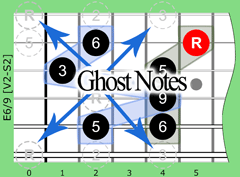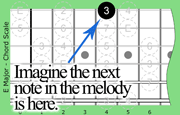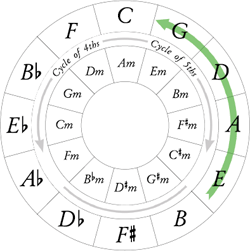More Information
Take your music to the next level with Prosonic Charts, a new series of cutting-edge books designed to give your playing a boost! Fretboard Chord Charts for Guitar will expand your tonal color palette, giving you more ways to express yourself through the guitar.
Imagine what would happen if you had more chords to work with... would your music really be that much better? Tony Pappas, creator of Prosonic Charts and well known for his work on the Ghosts of Orion project, put it this way,
"Chords are like colors, and a musician with only a couple of chords, is like a painter with only red and green, it's way too limiting. Having a wide variety of chords gives a musician options, and colorful chords give music a certain richness... a depth, and this book is full of them, everything from bright and beautiful to dark and demented."
Whether you're writing for guitar, or just want to jam along, this book will expand your harmonic vocabulary, allowing you to more fully express yourself on the instrument. So get some new chords and expand your harmonic universe today!
Many years ago, I was at a music store, and I opened one of those "Chord Dictionary" books. I flipped through it's pages, and slowly began to realize: it's going to take a long time to learn the guitar. The sheer number of chords in that book was staggering. (And, as I would find out later, it didn't even come close to the number of possibilities there are.) So I quietly closed that book, and put it back on the shelf.
A couple of years later I received "The Guitar Handbook." It showed how intervals are arranged on the fretboard and, after working with them for a while, I had a revelation:
If I know where all the intervals are, relative to a root note, then I could build any chord I desired, without needing to memorize a zillion chords!
This was a huge breakthrough! Finally, some music theory that actually worked, and this was powerful. I felt vindicated! That big 'ole chord dictionary wasn't so scary after all!
And I was RIGHT! ...to a point.
You see, while it is true that you can build chords this way, it can be quite cumbersome to do so. Especially when you're composing music. Not only must you have all the formulas memorized, but you must know the best voicing, at that particular spot on the guitar, with the best fingering, etc. Having to do this every time you need a chord can hinder "the creative flow" and this is when a good chord dictionary can come in handy. So...
What's a "Good" Chord Dictionary?
First: What is a chord dictionary? A chord dictionary is a set of chord diagrams, showing where the best voicings are on the instrument. It removes all the work in finding chords, which saves a lot of time.
So what's the best way to build one?
I've spent a lot of time considering that question, and an important thing I found is this: A good chord dictionary should contain transposable chords which should be built from one root note only.
Otherwise, if you didn't impose limitations, and included every chord, with every root note and every possible voicing for that root, the dictionary would be impractical. The book would be too big and you'd waste a lot of paper. So it's best to limit the book to transposable chords with one root note.
Another benefit of using transposable chords is you only need to diagram and memorize one shape for a particular formula. Instead of charting a separate chord for C major, E major, A major, Bb major, F# major, etc., you only need to chart one major chord, then you can transpose it to any root note you want. This also helps you focus on movable shapes
instead of focusing on block-chords at fixed-locations.
A good chord dictionary will also have multiple chords placed on a single 'fretboard diagram' so that your mind can easily visualize how they relate to each other. In other chord dictionaries, each chord is drawn in isolation on a separate diagram. This makes it hard to see how they connect across the fretboard.
Here's a comparison chart I made when researching what a "good" chord dictionary would be verses an "average" chord dictionary:
| "Better" Chord Dictionary |
"Average" Chord Dictionary |
| Covers the largest amount of formulas in the least amount of space. |
Includes a bunch of chords with different root notes but the same formula, wasting space (and paper) in the process. |
| Shows chords in a way that helps your mind visualize how they relate to each other and connect across the fretboard. |
Shows chords isolated from each other with no indication of their relativity. |
| Chord diagrams are big and printed in full color, helping the right hemisphere of the brain learn better. |
Chord diagrams are small, hard to read and are printed in boring black and white. |
| Shows other notes around the chord which may be added to expand voice count or used for ornamentation. |
Shows only the chord notes. |
| Has great categorization and a fast/easy way to look up chords. |
Presents chords in a haphazard format which lacks a good indexing/lookup system. |
Even though this book isn't a "chord dictionary", I've done a lot of research and extra work to make this book conform to what a "good" chord dictionary would be.
Why Four-Voice Chords?
There are very good reasons to focus on four-voice chords during the study of harmony as a guitarist.
- The Dominant 7th chord is arguably the most important chord in western harmony. Not only is it cadential, but it's also used extensively in jazz and blues. To play it, you need 4 voices:
1 3 5 ♭7
- Almost all harmonic studies are written in four voices (Bass, Tenor, Alto, Soprano). It's recommended that you master four-voice chords and good voice-leading as early as you can so that you'll be ready for those studies when you encounter them.
- As a guitarist, you basically have four fingers on each hand to play with. Sure, you can use "tricks" to get around this by using the thumb, double-stops, or barring, but for the most part you only have 4 fingers.
-
Four-voice chords leave the texture "open". I enjoy playing big chords that use all six strings, but this, with a few exceptions, only works well when you're playing alone.
When you're in a group, especially with a piano player, playing full six-note chords isn't the best way to play your part in the overall texture. It can get too thick if you use too many notes... you'll want to preserve transparency in the mix. That way, each note you do play, will have it's own space to breathe.
- If you know four-voice chords, you can easily make five and six voice chords by adding notes to the initial four. Take a look at the example below. If you take the major triads on the left and add ghost notes to them (indicated by the blue arrows) you'll have three, six-voice major triads, shown on the right.
| Four-Voice Chords |
easily become |
Six-Voice Chords |
Ghost Notes!

As you noticed above, "ghost notes" are faintly visible notes on all the charts.
Those ghost notes show where all the intervals in the formula are on the fretboard.
Ghost notes make it easy to see how the chords fit into the overall note matrix and they also make it easier to see what other notes you can grab to extend or ornament your chord with.
Chord Order
The chords have been arranged by Voice Group and Soprano String. The diagrams are ordered with the most common voice groupings first. Then they are ordered by soprano on string one, then string two, then three.
Notice that all the chords with soprano on string one are on Page 1 and all the chords with soprano on string two and three are located on Page 2.
I organized the charts this way so that you'll have all the chords in one place when harmonizing a melody note on a particular string.
How to Use this Book
There are many possible uses for this book. I won't cover them all here, but I will offer a couple of suggestions to get you started.
1. This book can help you find new voicings for writing and improvisation.
You'll often find yourself hearing the next note in a melody but you aren't sure what chord to harmonize it with or you want a fresh sound.
Here's an example of how you could use the book in this situation:

Let's say you're looking for a great chord to harmonize the Major 3rd of E (G#) and it's on the 1st string, 4th fret.
If you want to hear what it sounds like over a 7 chord, you would go to: "4-Voice E7 Page 1" in the charts and there you will find five possible chords to harmonize it with. They're circled in the example below:
2. This book can also be used for practicing position changes along the fretboard, giving you the added benefit of training your ears to the inversions.
It's a good idea to practice position changes both ascending and descending along the fretboard. So play each chord in a diagram up and down the guitar. As you practice them visualize these things:
1. The chord shape.
2. Where the root note is located in the chord.
3. How the chord relates to adjacent chords (do they share notes?)
Keep it simple in the beginning; play one chord per measure (or two chords per measure like pattern #1 below) then move on to more complex patterns. I've included a few here to get you started.
All the patterns I've included use only two chords (Am to E). This is to simplify things so you can focus on the picking-hand first. Then, after the pick-hand has mastered the pattern, you can focus on the fret-hand while practicing more complex chord changes.
As an example, let's say you're working on V4-S2 minor triads:
If you were to use right-hand pattern #2, you would play it like this:
The example above only goes through each chord once. However, what you really want to do is keep going up the neck, repeating the chords one octave higher, until you run out of room. Then come back down again. So the next chord you would play would be the root position chord at the 12th fret. (light-blue chord on the diagram)
Here are the right-hand patterns:
(the scores are a little small on the website but they are beautifully presented in the book)
If you're having trouble with any of the rhythms, they're available for download as MIDI files right here.

Once you can play a particular set of chords smoothly in E, ascending and descending, then move on to another key.
I suggest going around the cycle of 4ths (counter-clockwise around the circle of 5ths) so that the next key to learn would be A, then D, then G, and so on.
If you're a jazz player you may want to go directly to F, then B♭, E♭, A♭, etc., so that you can work on the flat keys right away.
Those are just a couple of ways you can use this book. There are many more and I'll be adding a few videos to show how I use it in my writing and improv sessions soon...
I hope this brief introduction has helped you to see the possibilities in this book. It's helped me tremendously and I'm sure it will help you too. If you have any questions or comments please don't hesitate to contact me.
Thank you for your interest!